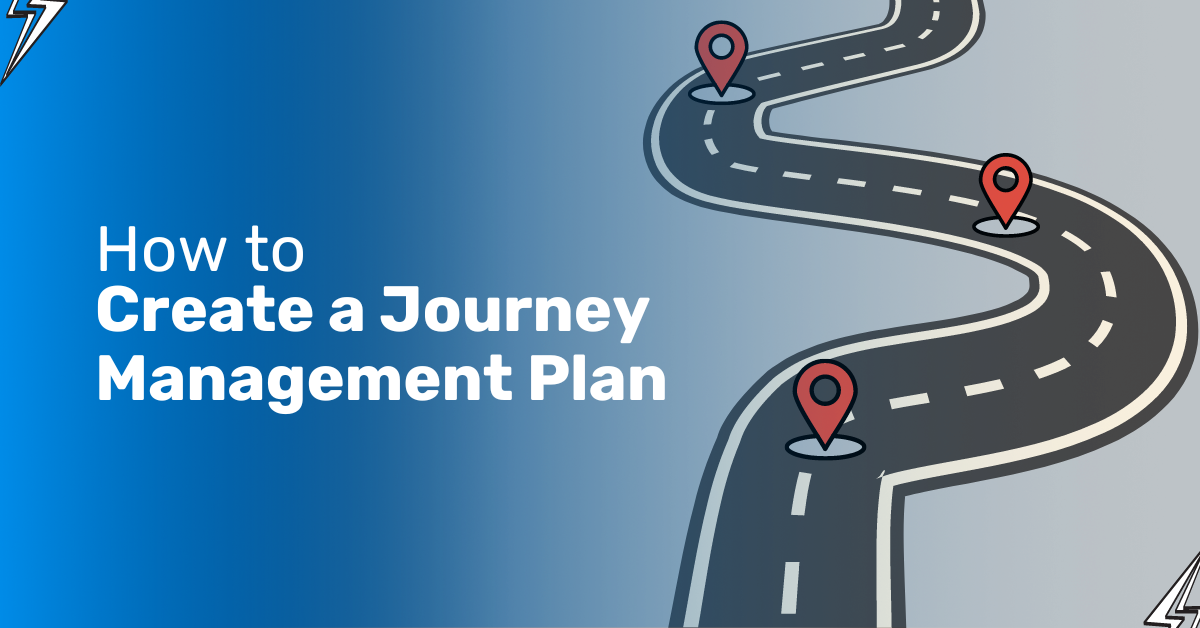Table of Contents
What is a Journey Management Plan?
A Journey Management Plan (JMP) is a guide to safe travels. With it, you can plan ahead, and make smart decisions about routes and potential challenges along the way. In the bigger picture, it is to ensure that everyone in the vehicle is safe and the trip is as stress-free as possible.
What can you find in a Journey Management Plan?
A Journey Management Plan can include various information based on the drivers or management choice, but it must include the following:
- A Map of the safest and most efficient routes
- Identifies potential hazards and risks
- Plans for emergencies and unexpected situations
- Sets guidelines for communication and coordination during the journey
Why is a Journey Management Plan (JMP) so crucial or Important?

1. Safe and Smooth Travels:
It is the responsibility of the logistics, travel or fleet team to ensure that the driver and its passengers can move from point A to B without unexpected challenges along the way. Whether as a long or short trip, safety measures have to be put in place.
2. Mitigating Risks in Transportation and Logistics:
Plying the road with your vehicle sometimes doesn’t go as you would expect. An example would be traffic congestion and weather conditions.
Using a Journey managment plan prepares you for these situations. You would have identified these situations and taken the necessary measures to minimize the likelihood of accidents or disruptions.
3. Saving Time and Money:
Did you know that following a journey management map can help reduce fuel consumption and downtime? Optimising the right routes steers you clear of situations that spike up your team’s expenses.
In addition to this, it ensures adherence to transportation laws and regulations, keeping you on the right side of compliance.
What are the different phases of a Journey management plan?
I. Pre-Planning Phase
Before you start your journey, there are a few important things to do. The pre-planning phase involves several key steps:
A. Identify the Purpose of the Journey:
To create a Journey Management plan, you need to understand why you’re going on this trip. Is it for work, fun, or some other reason? Knowing the purpose helps you plan better and ensure that all actions align with the intended goal.
B. Assess Risks and Hazards:
Before setting off, evaluate potential risks and hazards that could affect the journey. Look out for anything that could cause problems like traffic jams or bad weather.
- Traffic Patterns: Checking traffic patterns and potential congestion points helps you to anticipate delays and plan alternative routes.
- Weather Conditions: Check on weather forecasts to help you prepare for adverse conditions and adjust travel plans.
- Route Specific Risks: Identifying any specific risks associated with the chosen route, such as road construction or hazardous terrain, allows for proactive risk management.
- Vehicle Condition and Maintenance: Make sure your vehicle is in good shape. This will help minimize the risk of mechanical issues during the journey.
C. Find out who will be riding with you:
It’s as simple as asking the question who is coming? Clearly defining who will be participating in the journey ensures that everyone involved is accounted for and prepared. This includes passengers, drivers, and any other relevant individuals who play a role in the journey. This is essential when creating a journey managment plan.
D. Communication Protocols:
Make sure you have a way to communicate with others during the journey to coordinate activities and respond to any unexpected situations that may arise. This can be through phones or walkie-talkies.
II. Planning Phase
Now that you’ve done the pre-planning, it’s time to create a journey management plan:
A. Route Planning:
Choose the best way to get to your destination. Look for safe and efficient routes, anticipate potential disruptions, and plan alternative routes. It’s also important you have backup plans in case things change.
B. Scheduling:
when creating a journey management plan, you need to set a schedule for when you’ll leave and when you’ll arrive. Plan for breaks along the way to rest and recharge to ensure the journey stays on track and everyone involved knows what to expect.
C. Vehicle Requirements:
Make sure your vehicle is ready for the journey. Choose vehicles that are suitable for the terrain and conditions of the planned route. Consider factors such as size, capacity, and fuel efficiency and check that you have everything you need, like spare tyres, navigation tools, and communication devices.
D. Emergency Preparedness:
You handle situations well when you are ready for emergencies. Here are a few things to prepare for:
I. Ensure your vehicles are stocked with first aid kits and medical supplies to promptly respond to injuries or medical emergencies.
II. To create a journey management plan, you also need to keep a list of emergency contacts for quick communication and assistance in case of emergencies.
III. Establish clear procedures for handling emergencies, such as vehicle breakdowns or accidents.
III. Implementation Phase
Once the plan is set, it’s time to put it into action:
A. Brief Participants
- Review the Journey Plan: Before starting the journey, everyone involved should gather for a quick review of the journey plan to be on the same page on important details like the route, schedule, and safety procedures.
- Roles and Responsibilities: Each participant should be briefed on their roles and responsibilities during the journey to provide clarity and avoid confusion.
B. Monitor and Adjust the Plan
Throughout the journey, conditions should be monitored in real-time; keeping an eye on traffic, weather, and any other factors that may affect the journey.
If conditions change or unexpected obstacles arise, you should adjust the routes and schedules accordingly. Flexibility is key to adapting to changing circumstances and reducing disruptions.
Also, conduct regular check-ins to ensure that everyone is safe and that the journey is progressing smoothly.
IV. Post-Journey Evaluation
After the journey is complete, it’s time to evaluate how things went:
A. Assess Compliance with the Plan:
Review the journey plan to assess how well it was followed during the journey. See if there were any changes along the way. Such as adhering to safety protocol and so much more.
B. Identify Lessons Learned:
Lessons learned from the journey should be identified to inform future planning and decision-making. This may include areas where improvements can be made or particularly effective strategies.
C. Document Incidents and Near-Misses:
Any incidents or near-misses that occurred during the journey should be documented to identify potential areas for improvement and plan against such risks.
Be open to getting feedback from participants, to have an idea of areas for improvement.
E. Updating Risk Assessments and Contingency Plans:
This is based on the insights gained from the journey, to ensure the plan remains relevant and effective in mitigating risks for future journeys.
The planning and execution of a Journey might seem a breeze, but can be quite challenging and meticulous. But what if there was a smarter, more efficient way to manage your travels and fleet?

Why do you need a Journey Management Software or better still a Fleet Management software?
You most likely should be familiar with the term fleet management software than you are with a Journey management Software. It’s more common because it provides tools to manage more than just your journeys, but your fleet in general, its tracking, maintenance and so much more.
But what makes journey management software, or fleet management software important for transportation and logistics companies, public transportation authorities, emergency response and public safety agencies, construction and engineering firms and even Government Agencies and Military Organizations?
1. Finds you and your team the Best Routes:
- Route Optimization: Helps select the safest and fastest routes, minimizing fuel costs.
- Real-Time Updates: Receive real-time updates about traffic and weather, helping you avoid delays and problems.
- Seamless GPS Integration: Provides accurate navigation instructions, reducing the risk of getting lost.
2. Keep you and your team Safe on the Road:
- Risk Assessment: Identifies dangers along the journey and offers tools to address them.
- Incident Reporting: Users can report incidents or hazards encountered during their journeys. This information helps other riders from passing the same route.
- Communication Tools: Provides real-time communication among drivers and stakeholders, keeping everyone connected.
- Compliance Management: Helps comply with regulations and safety protocols.
- Maintenance Tracking: Tracks vehicle maintenance schedules and alerts you when maintenance is due, ensuring vehicles are in optimal condition.
- Vehicle Tracking: Allows you to track your vehicles in real-time, knowing their exact locations at every moment for enhanced safety and security.
- Preventive Maintenance Schedules: Helps schedule and track preventive maintenance tasks, reducing the risk of breakdowns and ensuring vehicle reliability.
Instanta Fleet Software provides all of the benefits mentioned above, to help manage your fleets and journeys, optimize routes and schedules for maximum efficiency, communicate with teams and partners effortlessly, gain actionable insights to improve future journeys
In conclusion, it’s important to understand that safety should be your first and top priority. You need to remember that planning, preparation, and a good software tool that manages your fleets, finds you the best route, tracks maintenance schedule, provides real-time communication among the team, and so much more.





















